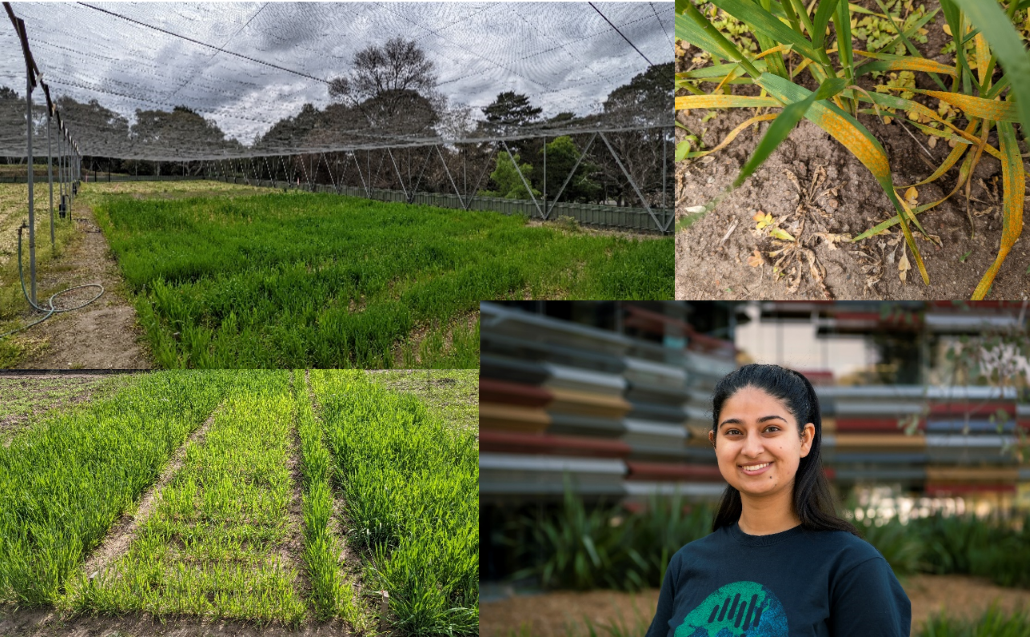PS PhD Exit Seminar - Investigating the diverse role of the wheat Lr67res gene: further insights into rust resistance and metabolites
Wheat production faces significant challenges from fungal pathogens, particularly rust diseases, which account for substantial global yield losses.
Speakers
Content navigation
Description

Abstract: Wheat production faces significant challenges from fungal pathogens, particularly rust diseases, which account for substantial global yield losses. Among these, stripe rust, caused by Puccinia striiformis f. sp. tritici (Pst), is a major threat, leading to an estimated annual loss of 5.47 million tons in global wheat yield. The Lr67res gene, a gain-of-function allele associated with partial, durable resistance to multiple pathogens, has been identified as a valuable wheat resistance gene. The Lr67res gain-of-function phenotype appears to be involved with anion transport. However, the full scope of its impact on plant growth vigour, gene expression, metabolism, and its interaction with agronomic factors such as nitrogen availability remains partially understood.
This study investigates the role of the Lr67res gene under field conditions with varied levels of nitrogen as a proxy for ionic variability (0, 150, and 300 kg/ha). Using wheat near-isogenic lines for Lr67res in cultivars Thatcher and Avocet, biomass allocation, disease resistance, gene expression and ionic content, along with metabolomic changes associated with Lr67res were characterised. Findings revealed that the Lr67res gene did not negatively affect above-ground biomass or agronomic traits in the absence of rust, but in the presence of rust infection, it conferred significant protection, preventing biomass loss typically observed in susceptible cultivars. Furthermore, the study demonstrated that Lr67res conferred partial resistance to stripe rust, significantly reducing fungal biomass (quantified via PstEF1 transcript levels), regardless of nitrogen treatment. This resistance was coupled with the induction of leaf tip necrosis (LTN) and Lr67 expression was induced by rust infection. Elevated chloride content was observed in Lr67res flag leaf tips compared to basal and sheath segments regardless of nitrogen treatment. Interestingly, Lr67res was associated with key metabolic pathways linked to plant defence, including sugar metabolism, lipid metabolism, and antioxidant activity. Relevant metabolite biomarkers associated with Lr67res were detected. The next steps involve determining the identity of the detected metabolite biomarkers.
This research enhances our understanding of the molecular and physiological basis of the Lr67res gene in wheat, in turn providing valuable knowledge for the application of durable resistance in future crops.
Biography: Preet is a PhD candidate at ANU in the Division of Plant Sciences jointly with CSIRO Agriculture and Food. She commenced her PhD in the latter half of 2021, navigating the challenges of starting research amid ACT’s final COVID-19 lockdown. Preet’s research focuses on understanding the physiological and molecular role of the Lr67res multi-pathogen resistance gene in wheat under field conditions. By integrating yield component analysis, gene expression profiling, untargeted metabolomics and protein localisation, her work provides insights into how Lr67res confers resistance without compromising plant growth and development. Prior to her PhD studies, Preet completed a Master of Science in Biotechnology at RMIT University, including a research internship with Dr Susie Sprague at CSIRO, where she contributed to efforts in quantifying Ascochyta infection in chickpea.
Location
Eucalyptus Seminar Room
S205, Level 2
RN Robertson Building (46)
Zoom link
https://anu.zoom.us/j/88137299402?pwd=7La91u57Pls6yqbbQQaDsmI5cK465b.1
Webinar ID - 881 3729 9402
Passcode - 460058
